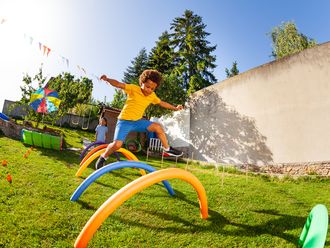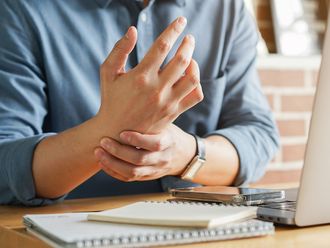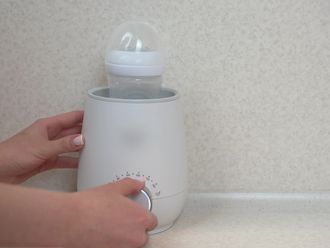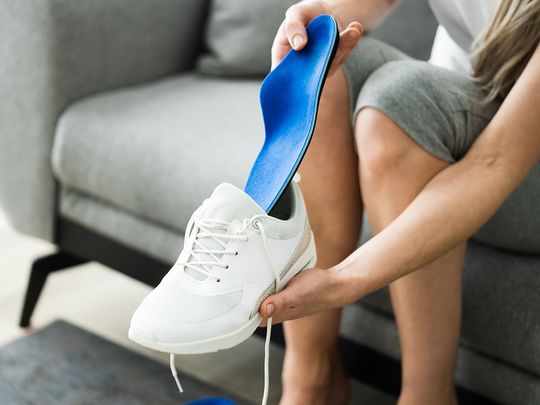
Often described as a stabbing pain in the heel, plantar fasciitis is much more common than we think. It’s an inflammation of the heel bone that can sneak up after a day’s rest, hindering our ability to walk, exercise or carry out daily chores on foot.
If you stand for hours at work or have overloaded that certain band of muscles in the feet while on vacation, then it’ll be helpful to know these at-home remedies from a podiatrist.
Michelle Champlin, chief podiatrist at the Dubai Podiatry Centre, takes us through the science behind plantar fasciitis, easy treatment tips to speed up the healing process, and foot health advice, down below. Scroll to see how you can prevent this recurring foot pain from spoiling your next holiday.
We’ve compiled a list of expert-recommended products, from footwear to arch support, that can ease plantar fasciitis pain day-to-day. You'll only find the best-rated options from Amazon, where a Prime membership will get you free, fast delivery.
1. Best Foot Bath: CureCure Foot Bath Massager
Pros
- Heats up water and maintains temperature
- Timer of up to 60 minutes
- Creates bubbles and relaxing vibrations
- Collapsible storage
Cons
- Rollers under the feet might be uncomfortable for some, but these can be removed
According to Champlin, a contrast bath for the feet will increase the rate of recovery, as hot and cold water therapy stimulates blood circulation in the injured area. You'll need to soak your feet in cool and warm water alternately, and a self-heating electric foot bath can help stabilise warm temperatures. CureCure's unit starts heating the water from 35 degrees Celsius and maintains it for up to an hour. The bed has 16 mini removable rollers that massage the bottom of the feet, together with a vibrating massage function and active oxygen bubbles to further pamper your soles. Keep a tub of cool water next to you to carry out the contrast bath. Our expert says to do this every evening five times, and time each soak for one minute. Those who are on their feet a lot use this foot bath in the reviews, and they find it to be a spa-like experience every time.
Warranty: Amazon offes a one-year extended warranty for Dh18 and two years for Dh25.
2. Best for Daily Support: Mueller PF Tape (7 Applications)
Support pads or a makeshift brace made out of kinesiology tape will lift some pressure off your arch and bring relief to your tender heel. This Mueller Plantar Fasciitis Tape can be worn with shoes comfortably and has seven applications that last up to 24 hours each. You don't need to cut the tape - each application comes pre-cut with clear instructions on how to stick the sole and arch strips. These strips have also been endorsed by the World Federation of Athletic Training and Therapy (WFATT). Reviewers incorporate this tape into their recovery plan by applying the support in the morning to ease pain and taking it off only in the evening after work, when they engage in massage techniques and other plantar fasciitis treatments.
3. Best Foot Roller: TheraBand Foot Roller
You could take a water bottle and roll it under the arch of your foot, or invest in a dedicated foot roller. Massaging with this for a few minutes every day will lengthen and stretch the fascia, bringing relief from the pain. The Thera-Band roller is made of natural latex material with a hollow core, so it can conform to any foot. Push the roller up against your feet in a back-and-forth motion to increase blood flow, and, therefore, oxygen for repair. People suffering from plantar fasciitis in the reviews leave glowing feedback, adding that it's the only roller that's managed to bring them immediate relief. Sometimes, buyers freeze the roller for cold therapy.
4. Best Arch Support: PowerStep Insoles Pinnacle, Low Arch
Foot arch support in the form of shoe inserts is going to take some load off your fascia and align your feet correctly. PowerStep has insoles for both low and high arches to provide adequate support from heel to toe for all types of feet. Each pair uses premium dual-layer cushioning made with EVA foam that sandwiches a semi-rigid support shell. Simply replace the original inserts in your shoe with these and walk as usual. Make sure to pick the right size and pair - this one is suited for low arches. Those with flat feet find them very comfortable even after a long day at work, and mention reduced pain not only in the feet but in the back as well.
5. Best Shoe: ASICS Gel-Nimbus 25 Women's Running Shoes
Pros
- Support for high and neutral arches
- Gel technology makes landing softer
- Promotes good foot health per APMA
- Sizes available in wide
Cons
- Design might seem unflattering for some
Footwear with plantar fasciitis is where the best shoe discussion gets tricky. Many manufacturers, from Hoka to Brooks, are often recommended, but one receives the most praise - Asics. The brand's Gel-Nimbus range is exactly what it sounds like, a walk on clouds, with great arch support, a roomy toe box and enough cushioning for shock absorption. The design has also been approved by the American Podiatric Medical Association (APMA) for promoting good foot health. It uses gel technology to provide softer landings in your step and caters to feet with neutral and high arches - you can always use your own inserts for flatter feet. This is a running pair for the road, but reviewers have worn the shoe to work long shifts with no discomfort. Many note that it performs better than their Hokas for plantar fasciitis. You can also pick from wide sizes in the available selection.
6. Best Supportive Socks: Plantar Fasciitis Socks by OS1st
Supportive socks can also go a long way in taking tension off your fascia. These specially designed quarter-crew socks by OS1st are made with the highest quality merino wool and treated with a moisture-wicking agent to control odour and sweat. It has medical-grade compression that targets four zones to improve circulation, reduce impact, boost recovery and strengthen the feet. One such zone uses firm compression around the arch to lift the plantar fascia. Reviewers say that it's made a world of difference to their chronic condition, calling it the most supportive socks they've ever tried.
7. Best Sandal: Skechers GOwalk Arch Fit Sandal
For casual errands, switch to sandals that will offer good arch support, like the Skechers' GOwalk Arch Fit sandal. It has a podiatrist-certified arch support on the footbed, which is contoured to fit your foot to reduce shock and increase weight distribution. You can adjust and tighten the sandal to your liking at the ankle, with snug loops behind the heel and over the toes. People with foot pain vouch for the pair, with their heels feeling great in them even after walking long distances on travel.
Why do I get plantar fasciitis or foot pain?
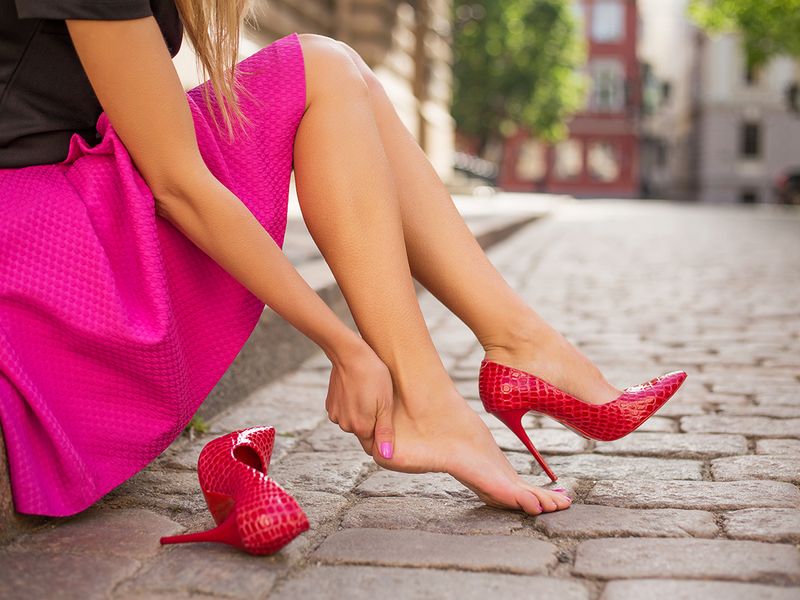
Anyone can suffer from an inflamed heel bone, especially those who are on their feet for prolonged periods of time, says Champlin. “It is prevalent among those who stand for their jobs, such as teachers, hairdressers and chefs.” Plantar fasciitis is so common that it can affect people several times during their lifetime, she adds.
It comes about when our foot’s plantar fascia is strained, “a very strong, thick band of collagen fibres that connects the forefoot to the rear foot”. Repetitive load on the fascia band makes it ‘pull’ on the heel bone, which eventually becomes inflamed.
We can overload our plantar fascia in many ways, besides standing on our feet for hours. It could be from weight gain, wearing shoes with little to no support, changing hormones in the body and even a collapsed foot arch or flatfoot.
Champlin explained: “The role of the plantar fascia is to engage the arch of the foot, so if the arch is actively collapsing, the plantar fascia will engage more, creating inflammation to the heel bone from where it is attached.”
It’s not atypical for plantar fasciitis to show up once you’ve rested. The pain seeps in after experiencing load, which is why, says Champlin, most sufferers are confused when they find their foot hurting after rest.
What is the best way to treat plantar fasciitis?

The good news is that the condition is temporary, and the pain ebbs away with in a month – sometimes even after a few minutes of walking. However, it can get recurrent if proper care is overlooked.
“The feet are the poorest area of the body. They are the furthest extremity from the heart and lungs and can take longer to heal after injury,” said Champlin. “It can usually take 12 weeks for plantar fasciitis to completely go away when going through treatments, as the nature of the inflammation of the heel bone, where the plantar fascia is attached, takes time to settle and repair completely. So, don’t give up hope.”
If you’re still in pain after this period of time, then a visit to the podiatrist is in order. With a fresh plantar fasciitis injury, you can perform a handful of remedies to alleviate the pain and speed up recovery at home.
Champlin suggests a contrast foot bath in cold and warm water, alternating between the two temperatures every minute, five times. “[The repeating process] encourages nutrient-rich oxygenated blood to the feet and, then, removing it with the help of the cool water. This helps with the removal of cellular waste products from the repair process of the injured area,” she explained.
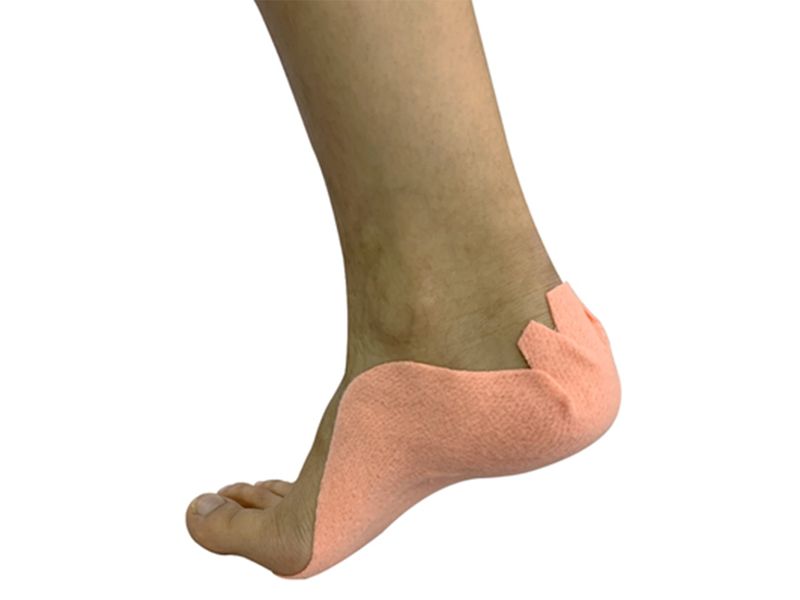
You can also massage the arch of your foot with a cold water bottle or a tennis ball for a few minutes. Massaging the area can help reduce pain and swelling.
You could also invest in “corrective and accommodative orthotics” to relieve tensile stress on the plantar fascia. These can be supportive insoles for existing shoes. Other forms of relief can be found in adhesive support pads and a good pair of firm sports shoes.
Frequent foot pain is preventable by making the feet stronger, and this begins with proper nutrition and diet. Champlin offers more foot health guidance:
- Making sure your vitamin D, calcium, glucose, vitamin B are all in balance can help the feet.
- Picking up a sock repeatedly with your toes can help keep the foot muscles strong.
- Staying within a healthy weight range and keeping active, such as walking, can help reduce the load and stress on the feet while also keeping them strong.
- Checking your feet annually by a podiatrist can address any small issues before biomechanical complaints take hold.
- Wear good supportive shoes that give the feet plenty of space to move.
Our recommendations are independently chosen by Gulf News editors. If you decide to shop through links on our website, we may earn an affiliate commission, as we are part of Amazon Services LLC Associates Program.


